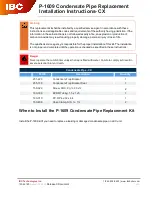
3.6 Gas conversions
Changing a boiler over from natural gas
to LPG and vice versa is only to be carried
out by qualified personnel.
To check the setting values for the
nozzles and gas supply pressure, use a
pressure gauge connected to the
pressure sockets on the valves.
3.6.1 Conversion from natural gas to
LPG
Proceed as follows:
• Remove the natural gas nozzle from the
pilot burner after having unscrewed the
nut that holds the olive and vent the gas
supply pipe to the pilot burner.
• Position the LPG nozzle checking that it
is as indicated in the technical data table,
and after repositioning the gas supply
pipe tighten the nut that secures the
olive.
• Remove the natural gas nozzle on the
main burner and fit the LPG nozzle,
checking that this is as indicated in the
technical data table.
• Unscrew the pressure regulating cap on
the gas valve and tighten the pressure
regulating screw all the way.
• Screw the pressure regulating cap back
on and seal it (using paint or a self-
adhesive label, for example).
NOTE: for models RTN E 60 to RTN E
100 the regulating operations must be
carried out on both gas valves.
• Check the gas circuit for leaks, especially
the points that were disconnected.
• Affix the self-adhesive label provided
that indicates the type of gas and
pressure for which the equipment is set.
3.6.2 Conversion from LPG to natural
gas
Proceed as follows:
• Remove the LPG nozzle from the pilot
burner after having unscrewed the nut
that holds the olive and vent the gas
supply pipe to the pilot burner.
• Position the natural gas nozzle checking
that it is as indicated in the technical data
table, and after repositioning the gas
supply pipe tighten the nut that secures
the olive.
• Remove the LPG nozzle on the main
burner and fit the natural gas nozzle,
checking that this is as indicated in the
technical data table.
• Unscrew the pressure regulating cap on
the gas valve and unscrew the pressure
regulating screws so that the pressure at
the outlet is as specified in the technical
data table.
• Screw the pressure regulating cap back
on and seal it (using paint or a self-
adhesive label, for example).
NOTE: for models RTN E 60 to RTN E
100 the regulating operations must be
carried out on both gas valves, taking
care to balance them correctly.
• Check the gas circuit for leaks, especially
the points that were disconnected.
• Affix the self-adhesive label provided
that indicates the type of gas and
pressure for which the equipment is set.
19
4. MAINTENANCE
In order to ensure that the equipment is
efficient and that it functions correctly,
maintenance must be carried out
annually, based on the programme laid
out below:
It is obligatory for all maintenance
(and repair) operations to be carried
out by qualified personnel.
Before starting any maintenance work
that involves replacing components
and/or cleaning the inside of the boiler,
disconnect the equipment from the
electrical power supply.
Maintenance programme
Routine maintenance must include the
following checks:
- Check of the general integrity of the
boiler.
- Checking the gas supply to the boiler for
leaks.
- Checking ignition of the boiler.
- Checking the boiler’s combustion
parameters by analysing the flue gas (this
check is done every two years if the boiler
is installed on its own.
Where the boiler is installed in a cascading
system, this check is run annually).
- Checking the integrity, good state of
preservation, and tightness test on the
flue gas discharge system.
- Checking the integrity of safety devices
on the boiler in general.
- Checking for water leaks and rusting on
the boiler’s couplings.
- Checking the efficiency of the system’s
safety valve.
The following cleaning is to be done
(with the boiler cold):
- General internal cleaning of the boiler.
- Cleaning of the burner and resetting of
the same if necessary, as per instructions
provided by the manufacturer.
- Cleaning of the ventilation grille for the
boiler room.
- Cleaning of the flue gas side of the heat
exchanger. This can be done using swabs
and vacuum cleaners to remove soot
deposits on the sides and fins used for
exchanging heat.
Alternatively specific chemical products
can be used in compliance with the
instructions for use of the same.
Do not use inflammable products such
as petrol, solvents or any other such
material to clean the heat exchanger.
When working on the boiler for the
first time, check:
- The suitability of the boiler room.
- The ventilation openings in the room.
- The flue gas discharge ducts, and the
diameters and lengths of these.
- That the boiler has been correctly
installed as per instructions contained
in this booklet.
If the equipment is not able to work
correctly, or where it poses any danger
to people, animals or property, inform
the person responsible for the plant
and draw up a statement in this regard
Содержание BALI RTN 18
Страница 1: ...BALI RTN IST 03 C 358 01 INSTALLATION USE AND MAINTENANCE EN...
Страница 15: ...3 5 1 General layout mod 18 48 RTN E fig 7 mod 18 48 RTN fig 6 15...
Страница 16: ...mod 70 100 RTN E fig 9 mod 60 RTN E fig 8 16...
Страница 17: ...mod 18 48 RTN E 3 5 2 Topographical diagrams fig 7A mod 18 48 RTN fig 6A 17...
Страница 18: ...mod 60 RTN E fig 8A mod 70 100 RTN E fig 9A 18...


































